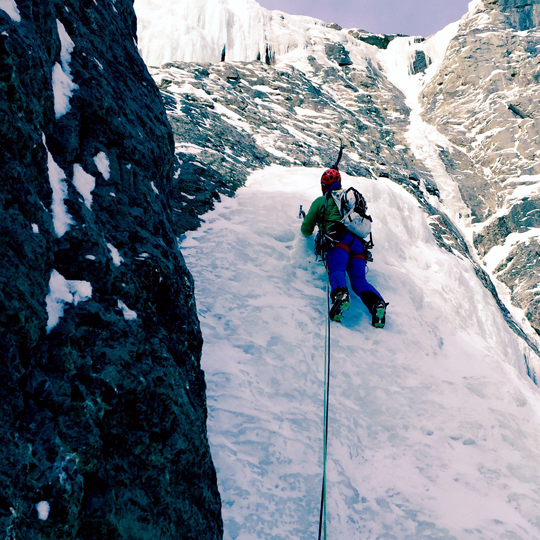[Photo] Kelly Grant
MSRP: $500 Dyneema 2400 Ice Pack/$285 Standard 2400 Ice Pack
We packed up camp high on the Roosevelt Glacier and began climbing towards Mt. Baker’s North Ridge (WI2-3, 3,000′, Beckey-Widrig, 1948), in Washington’s North Cascades, at 6 a.m. Challenging weather conditions required creative route finding. At noon, six hours later, we climbed into a storm below the summit. Battered by hurricane winds in a whiteout, rime accumulated on every windward surface–ice tools, clothing, packs and faces. Exhausted by the weather, we stumbled downward in the strong storm, setting up camp on the first sheltered, level ground we found.
This was the first time that I climbed with Hyperlite Mountain Gear’s Dyneema 2400 Ice Pack. As I unpacked my dry tent and clothes, it was not the first time I was thankful to use the Ice Pack. Its 40L capacity carried camping and climbing gear for my three-day alpine trip through forest, over moraines and glaciers and in the high-elevation tempest.
At 966g, it is lighter than most climbing packs of similar capacity, which goes a long way to lighten three days of gear. The padded shoulder straps and hip belt, made of three-eighth-inch closed-cell foam, easily handled my 30-pound load. The hip belt also has another one-eighth-inch layer of stiff foam which prevents it from curling under itself. The roll-top closure system permits vertical compression, and side compression straps lessen the Ice Pack’s size when not fully loaded. A simple Y-strap on top secures a rope, pad and other gear. The external crampon and ice tool attachment systems are simple and securely hold gear in place. Additional features include removable stays, four external daisy chains and an elastic sternum strap. Custom features are side panels made of Dyneema, a holster for skis ($100) and zippered pockets on the hip belt ($10).
One-hundred percent woven Dyneema is laminated over Cuben Fiber to create a 90-percent waterproof fabric that’s lightweight and resistant to tearing and fire. The pack’s only seam that is not sealed is on the bottom, so it’s best not to drop it in a puddle or submerge it in water.

[Photo] Kelly Grant
To make the pack watertight, use waterproof bags or stuff sacks. “All of our packs have a face fabric laminated to the Cuben Fiber that provides the [near] waterproofness,” Dan St. Pierre, CFO and co-founder of Hyperlite Mountain Gear, said.
The cavernous interior epitomizes HMG’s no-frills philosophy with only a postcard-sized zippered pocket for small items like keys, gel packs and phone. The pack’s other zipper is for a small pocket on the left hip (a customizable feature) that accommodates energy food or a small GPS unit.
Besides being lightweight, the pack is durable. After the Mt. Baker trip, I dragged the Ice Pack around rubble peaks in the North Cascades and up ice routes in the Canadian Rockies. It looks the same as the day I picked it up in Maine months ago.
Pros: Durable, strong, water resistant, light, functional.
Cons: Expensive.